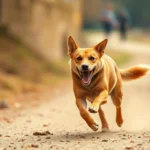
Understanding resource guarding in dogs is crucial for any dog owner who wants to foster a harmonious living environment for their pets and family. Resource guarding is a behavioral issue that can lead to conflicts and misunderstandings, especially if not properly addressed. This article will delve into the intricacies of resource guarding, exploring its definition, signs, causes, and effective strategies to manage it.
Understanding Resource Guarding
Definition of Resource Guarding
Resource guarding occurs when a dog displays defensive behaviors to protect items or spaces they consider valuable. These resources can be anything from food, toys, and bones to space, people, or even certain areas of the home. A dog exhibiting resource guarding may become aggressive or defensive if they feel their valued items are threatened or approached by others.
For example, a dog may growl or snap when someone approaches their food bowl, or they might stiffen and stare when someone reaches for their favorite toy. Understanding this behavior is essential for dog owners, as it can prevent unnecessary confrontations and ensure the safety of both the dog and the people around them.
The Psychology Behind Resource Guarding
The instinctual nature of resource guarding is deeply rooted in the survival instincts of canines. In the wild, resources like food and shelter are limited, and protecting these resources is vital for survival. While domesticated dogs often live in a different environment with plenty of food and socialization, these instincts can still manifest, particularly in certain breeds predisposed to guarding behaviors.
It’s essential to recognize the difference between normal protective behavior and excessive guarding. While it’s natural for dogs to protect their resources to some extent, excessive guarding can lead to problematic behaviors that require intervention.
Signs of Resource Guarding
Common Behavioral Indicators
Identifying resource guarding early on can help mitigate potential issues down the line. Common signs include:
- Growling: A clear warning sign that the dog is not comfortable with someone approaching their resource.
- Snapping: A more aggressive response that indicates the dog feels threatened.
- Body Language: Look for stiff posture, lip curling, and a fixed gaze, all of which indicate discomfort or aggression.
Visual cues can help in understanding when a dog is guarding its resources. A dog that suddenly becomes tense or freezes when someone approaches its food or toy is likely displaying guarding behavior.
Types of Resource Guarding
Resource guarding can range in severity, and understanding the differences is key to addressing the behavior effectively.
- Mild Guarding: The dog may simply growl or show mild discomfort but does not escalate to aggressive behavior.
- Moderate Guarding: This might include snapping or lunging when approached, indicating a higher level of distress.
- Severe Guarding: This includes full-blown aggression and might pose a danger to humans or other pets.
Different resources can elicit various responses. For instance, a dog might be more protective of its food bowl than of a toy, or it could guard its personal space more fiercely than other resources.
Causes of Resource Guarding
Genetic Factors
Certain breeds are more predisposed to resource guarding than others. Breeds that were historically used for herding or guarding, such as Border Collies or Rottweilers, may have stronger instincts to protect their resources. Understanding your dog’s breed tendencies can help in anticipating and addressing guarding behaviors.
Environmental Influences
How a dog is raised and its early experiences play a pivotal role in developing resource guarding behaviors. Dogs that are not properly socialized during puppyhood may be more prone to guarding. Early interactions with people, other pets, and various environments can shape how a dog perceives threats to its resources.
Stress and Anxiety
Stressful situations can exacerbate resource guarding behaviors. Changes in the household, such as moving to a new home, the arrival of a new pet, or even changes in routine can trigger anxiety in dogs. Dogs that are already anxious may become more defensive of their resources as a coping mechanism.
Addressing Resource Guarding
Prevention Strategies
Preventing resource guarding is often easier than addressing it once it has become a problem. Early socialization and training are crucial. Introducing your dog to various environments, people, and other animals can help them feel more secure and less inclined to guard their resources.
Modification Techniques
If resource guarding has already developed, several modification techniques can help.
- Desensitization: Gradually exposing your dog to the resource while remaining calm can help them learn that there is no threat. Start with the dog at a distance and gradually reduce that distance over time.
- Counter-conditioning: This technique involves changing the dog’s emotional response to the resource. For example, every time someone approaches the dog while it’s eating, the owner can toss a treat to create a positive association with people being near.
Using positive reinforcement is vital in these scenarios. Rewarding your dog for calm behavior around resources can gradually reduce their anxiety and guarding tendencies.
Professional Help
In some cases, seeking help from a professional trainer or behaviorist can be beneficial. These professionals can provide tailored behavior modification programs that address specific needs and situations, ensuring both the dog and the owner feel safe and supported.
Living with a Resource Guarding Dog
Management Techniques
Managing a dog that exhibits resource guarding behaviors requires practical strategies. Here are some tips for safely cohabiting with a guarding dog:
- Feeding Practices: Feed your dog in a quiet area away from distractions. Consider using a crate for feeding if the dog shows signs of guarding.
- Toys and Playtime: Supervise playtime and rotate toys to minimize the chance of guarding. If necessary, remove particularly valued toys when not supervised.
- Family Interactions: Instruct family members on how to interact with the dog safely, ensuring they understand the signs of guarding behavior.
Building Trust and Confidence
Creating a secure environment for your dog is essential. Trust-building exercises can help alleviate anxiety and reduce guarding behaviors. Spend quality time with your dog, engaging in activities they enjoy, and gradually increase physical closeness while rewarding calm behavior.
Integrating Family and Other Pets
Introducing children and other pets to a dog that exhibits resource guarding requires careful planning. Supervise interactions and teach children to respect the dog’s space and resources. Gradually introduce pets while monitoring their behavior, ensuring that all animals feel safe and secure.
Conclusion
Understanding and addressing resource guarding in dogs is essential for fostering a safe and harmonious environment. By recognizing the signs, causes, and effective management techniques, dog owners can navigate this challenging behavior with compassion and informed strategies. Engaging in ongoing education about dog behavior can empower owners to create a nurturing home for their pets, promoting trust and confidence.









